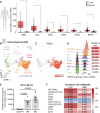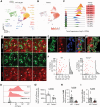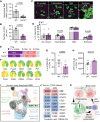TREM2 mediates MHCII-associated CD4+ T-cell response against gliomas
- PMID: 37941134
- PMCID: PMC11066911
- DOI: 10.1093/neuonc/noad214
TREM2 mediates MHCII-associated CD4+ T-cell response against gliomas
Abstract
Background: Myeloid cells comprise up to 50% of the total tumor mass in glioblastoma (GBM) and have been implicated in promoting tumor progression and immunosuppression. Modulating the response of myeloid cells to the tumor has emerged as a promising new approach for cancer treatment. In this regard, we focus on the Triggering Receptor Expressed on Myeloid Cells 2 (TREM2), which has recently emerged as a novel immune modulator in peripheral tumors.
Methods: We studied the TREM2 expression profile in various patient tumor samples and conducted single-cell transcriptomic analysis in both GBM patients and the GL261 mouse glioma model. We utilized multiple mouse glioma models and employed state-of-the-art techniques such as invivo 2-photon imaging, spectrum flow cytometry, and in vitro co-culture assays to study TREM2 function in myeloid cell-mediated phagocytosis of tumor cells, antigen presentation, and response of CD4+ T cells within the tumor hemispheres.
Results: Our research revealed significantly elevated levels of TREM2 expression in brain tumors compared to other types of tumors in patients. TREM2 was predominantly localized in tumor-associated myeloid cells and was highly expressed in nearly all microglia, as well as various subtypes of macrophages. Surprisingly, in preclinical glioma models, TREM2 deficiency did not confer a beneficial effect; instead, it accelerated glioma progression. Through detailed investigations, we determined that TREM2 deficiency impaired the ability of tumor-myeloid cells to phagocytose tumor cells and led to reduced expression of MHCII. This deficiency further significantly decreased the presence of CD4+ T cells within the tumor hemispheres.
Conclusions: Our study unveiled a previously unrecognized protective role of tumor-myeloid TREM2. Specifically, we found that TREM2 enhances the phagocytosis of tumor cells and promotes an immune response by facilitating MHCII-associated CD4+ T-cell responses against gliomas.
Keywords: TREM2; glioma; tumor-associated macrophages.
© The Author(s) 2023. Published by Oxford University Press on behalf of the Society for Neuro-Oncology. All rights reserved. For commercial re-use, please contact reprints@oup.com for reprints and translation rights for reprints. All other permissions can be obtained through our RightsLink service via the Permissions link on the article page on our site—for further information please contact journals.permissions@oup.com.
Conflict of interest statement
None declared.
Figures




Update of
-
TREM2 mediates MHCII-associated CD4+ T cell response against gliomas.bioRxiv [Preprint]. 2023 Apr 6:2023.04.05.535697. doi: 10.1101/2023.04.05.535697. bioRxiv. 2023. Update in: Neuro Oncol. 2024 May 3;26(5):811-825. doi: 10.1093/neuonc/noad214. PMID: 37066234 Free PMC article. Updated. Preprint.
Comment in
-
TREM2 function in glioblastoma immune microenvironment: Can we distinguish reality from illusion?Neuro Oncol. 2024 May 3;26(5):840-842. doi: 10.1093/neuonc/noae019. Neuro Oncol. 2024. PMID: 38290471 Free PMC article. No abstract available.
References
-
- Binnewies M, Pollack JL, Rudolph J, et al.. Targeting TREM2 on tumor-associated macrophages enhances immunotherapy. Cell Rep. 2021;37(3):109844. - PubMed
Publication types
MeSH terms
Substances
Grants and funding
LinkOut - more resources
Full Text Sources
Medical
Research Materials

